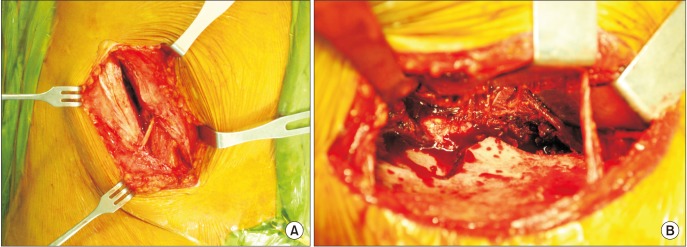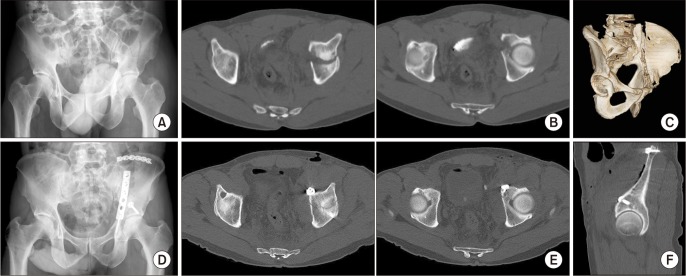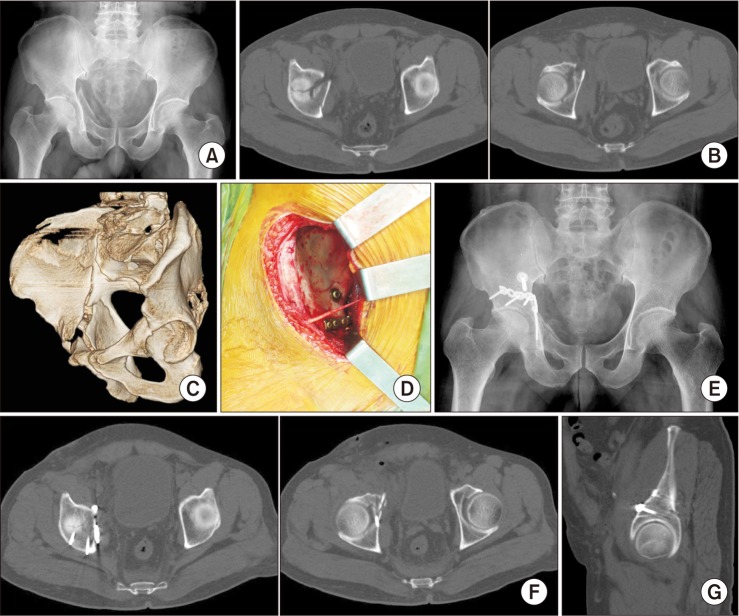Clin Orthop Surg.
2018 Sep;10(3):279-285. 10.4055/cios.2018.10.3.279.
Less Invasive Anterior Iliac Approach and Compression Osteosynthesis for the Treatment of High Anterior Column Fractures of the Acetabulum
- Affiliations
-
- 1Department of Orthopaedic Surgery, Daegu Fatima Hospital, Daegu, Korea. femur1973@gmail.com
- KMID: 2418746
- DOI: http://doi.org/10.4055/cios.2018.10.3.279
Abstract
- BACKGROUND
Displaced anterior column fractures have increasingly been treated surgically by the ilioinguinal approach and fixation with lag screws and a buttress plate on the pelvic brim. However, a major disadvantage of the ilioinguinal approach is possible damage to the neurovascular bundle and the lymphatic structures in the intermediate part of the approach. This study aims to present a novel surgical technique of the less invasive anterior iliac approach and compression osteosynthesis for high anterior column fractures of the acetabulum.
METHODS
In this retrospective case series, 19 patients treated operatively for isolated high anterior column fractures using the less invasive anterior iliac approach and compression osteosynthesis were included. Patient demographics, the cause of injury, associated injuries, time to surgical reconstruction, and operation time were collected from the medical records. The quality of reduction was assessed by postoperative standard radiographic views and computed tomography scans and graded according to Matta's criteria. Clinical and radiographic grades were assessed according to Matta's criteria at the last follow-up.
RESULTS
This less invasive surgical technique was successful for reduction and fixation in all high anterior column fractures and provided sufficient stability to allow immediate mobilization of the patients after surgery. Twelve fractures were combined with the quadrilateral plate fracture and seven fractures did not involve the quadrilateral plate. According to Matta's criteria, anatomical reduction was obtained in 17 patients and imperfect reduction in two patients. Clinical results were excellent in 17 patients and good in two patients. Radiographic results were excellent in 17 patients and good in two patients. Ten patients had neurapraxia of the lateral femoral cutaneous nerve related to the approach, which was resolved completely in seven. One patient had deep vein thrombosis.
CONCLUSIONS
Our less invasive surgical technique of the anterior iliac approach and compression osteosynthesis is a useful addition to the existing techniques in the treatment of high anterior column fractures of the acetabulum. Despite being a limited approach and fixation, this technique provides sufficient exposure for reducing and fixing the fracture and adequate stability to allow immediate mobilization of the patient after surgery.
Keyword
MeSH Terms
Figure
Reference
-
1. Letournel E, Judet R. Fractures of the acetabulum. 2nd ed. Berlin: Springer-Verlag;1993. p. 431–436.2. Matta JM. Fractures of the acetabulum: accuracy of reduction and clinical results in patients managed operatively within three weeks after the injury. J Bone Joint Surg Am. 1996; 78(11):1632–1645. PMID: 8934477.3. Mayo KA. Open reduction and internal fixation of fractures of the acetabulum: results in 163 fractures. Clin Orthop Relat Res. 1994; (305):31–37.
Article4. Heeg M, Otter N, Klasen HJ. Anterior column fractures of the acetabulum. J Bone Joint Surg Br. 1992; 74(4):554–557. PMID: 1624515.
Article5. Giannoudis PV, Kanakaris NK, Dimitriou R, Mallina R, Smith RM. The surgical treatment of anterior column and anterior wall acetabular fractures: short- to medium-term outcome. J Bone Joint Surg Br. 2011; 93(7):970–974. PMID: 21705573.6. Hirvensalo E, Lindahl J, Bostman O. A new approach to the internal fixation of unstable pelvic fractures. Clin Orthop Relat Res. 1993; (297):28–32.
Article7. Cole JD, Bolhofner BR. Acetabular fracture fixation via a modified Stoppa limited intrapelvic approach: description of operative technique and preliminary treatment results. Clin Orthop Relat Res. 1994; (305):112–123. PMID: 8050220.
Article8. Wolf H, Wieland T, Pajenda G, Vecsei V, Mousavi M. Minimally invasive ilioinguinal approach to the acetabulum. Injury. 2007; 38(10):1170–1176. PMID: 16979170.
Article9. Jakob M, Droeser R, Zobrist R, Messmer P, Regazzoni P. A less invasive anterior intrapelvic approach for the treatment of acetabular fractures and pelvic ring injuries. J Trauma. 2006; 60(6):1364–1370. PMID: 16766988.
Article10. Letournel E. The treatment of acetabular fractures through the ilioinguinal approach. Clin Orthop Relat Res. 1993; (292):62–76.
Article11. Matta JM. Operative treatment of acetabular fractures through the ilioinguinal approach: a 10-year perspective. Clin Orthop Relat Res. 1994; (305):10–19.
Article12. Ruchholtz S, Buecking B, Delschen A, et al. The two-incision, minimally invasive approach in the treatment of acetabular fractures. J Orthop Trauma. 2013; 27(5):248–255. PMID: 22810546.
Article13. Sagi HC, Afsari A, Dziadosz D. The anterior intra-pelvic (modified rives-stoppa) approach for fixation of acetabular fractures. J Orthop Trauma. 2010; 24(5):263–270. PMID: 20418730.
Article14. Shazar N, Eshed I, Ackshota N, Hershkovich O, Khazanov A, Herman A. Comparison of acetabular fracture reduction quality by the ilioinguinal or the anterior intrapelvic (modified Rives-Stoppa) surgical approaches. J Orthop Trauma. 2014; 28(6):313–319. PMID: 24100918.
Article15. Bastian JD, Tannast M, Siebenrock KA, Keel MJ. Mid-term results in relation to age and analysis of predictive factors after fixation of acetabular fractures using the modified Stoppa approach. Injury. 2013; 44(12):1793–1798. PMID: 24008225.
Article16. Vikmanis A, Vikmanis A, Jakusonoka R, Jumtins A, Pavare Z. Mid-term outcome of patients with pelvic and acetabular fractures following internal fixation through a modified Stoppa approach. Acta Orthop Belg. 2013; 79(6):660–666. PMID: 24563971.17. Mallina RK, Kanakaris NK, Tzioupis C, Giannoudis PV. Clinical outcomes following reconstruction of anterior column: anterior wall fractures of the acetabulum. Injury Extra. 2009; 40(10):218.18. Mokawem M, Kanakaris NK, Mallina RK, Giannoudis PV. Medium to long term results of acetabular reconstruction following anterior column and anterior wall fractures. Injury Extra. 2011; 42(9):124–125.
Article19. Tile M, Helfet DL, Kellam JF. Fractures of the pelvis and acetabulum. 3rd ed. Philadelphia, PA: Lippincott Williams & Wilkins;2003. p. 629–661.20. Gras F, Marintschev I, Schwarz CE, Hofmann GO, Pohlemann T, Culemann U. Screw-versus plate-fixation strength of acetabular anterior column fractures: a biomechanical study. J Trauma Acute Care Surg. 2012; 72(6):1664–1670. PMID: 22695438.
- Full Text Links
- Actions
-
Cited
- CITED
-
- Close
- Share
- Similar articles
-
- Anterior Approach for the Acetabular Fractures
- Modified Iliofemoral Approach using ASIS Osteotomy in the Pelvis
- Management of Fractures of Distal Tibia by Minimally Invasive Plate Osteosynthesis through an Anterior Approach
- Combined Anterior and Posterior Approach in Operating on Complex Acetabular Fractures
- Anatomic Consideration of Safe Zone in Plate-Screw Fixation of the Anterior Column of the Acetabulum




